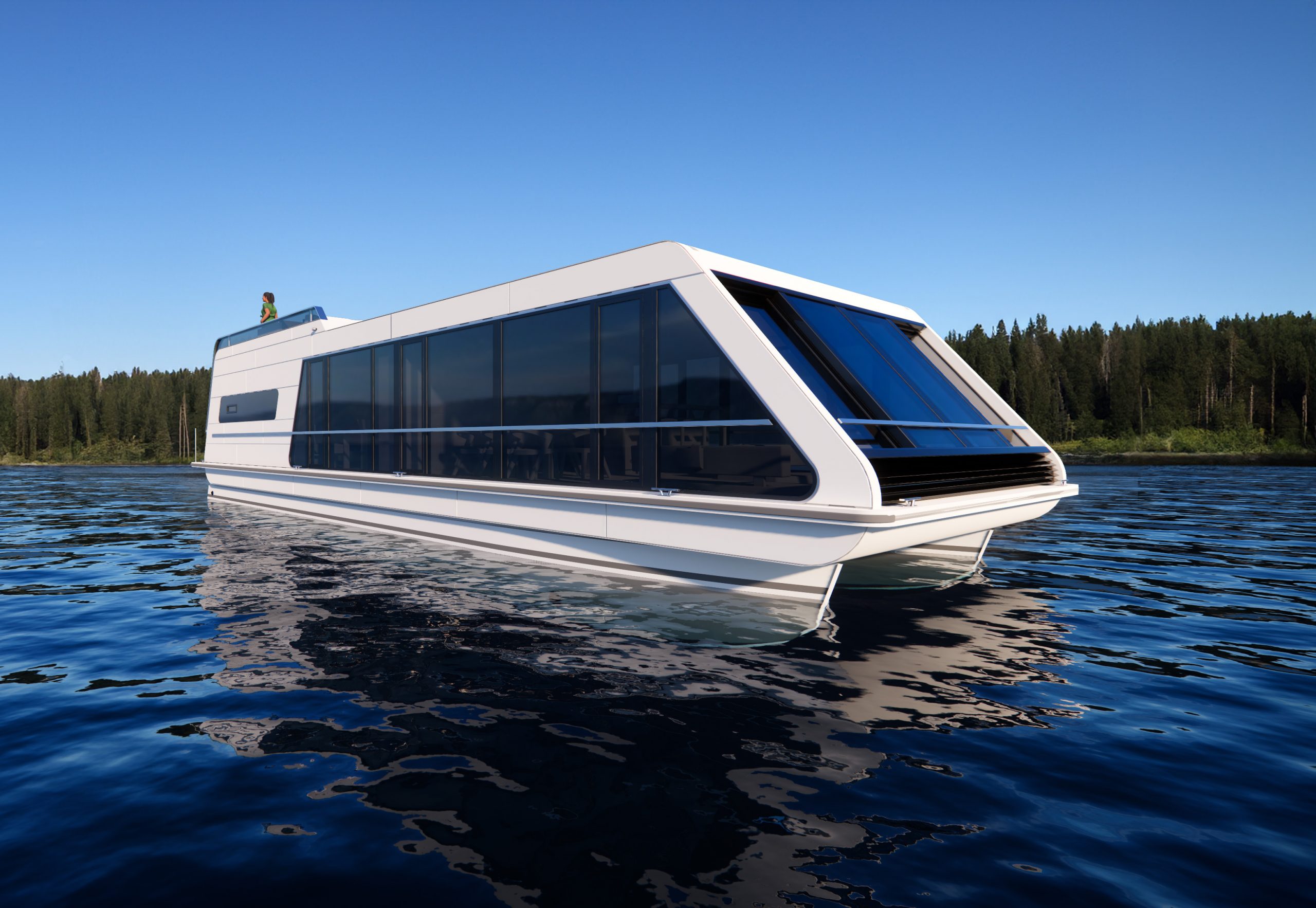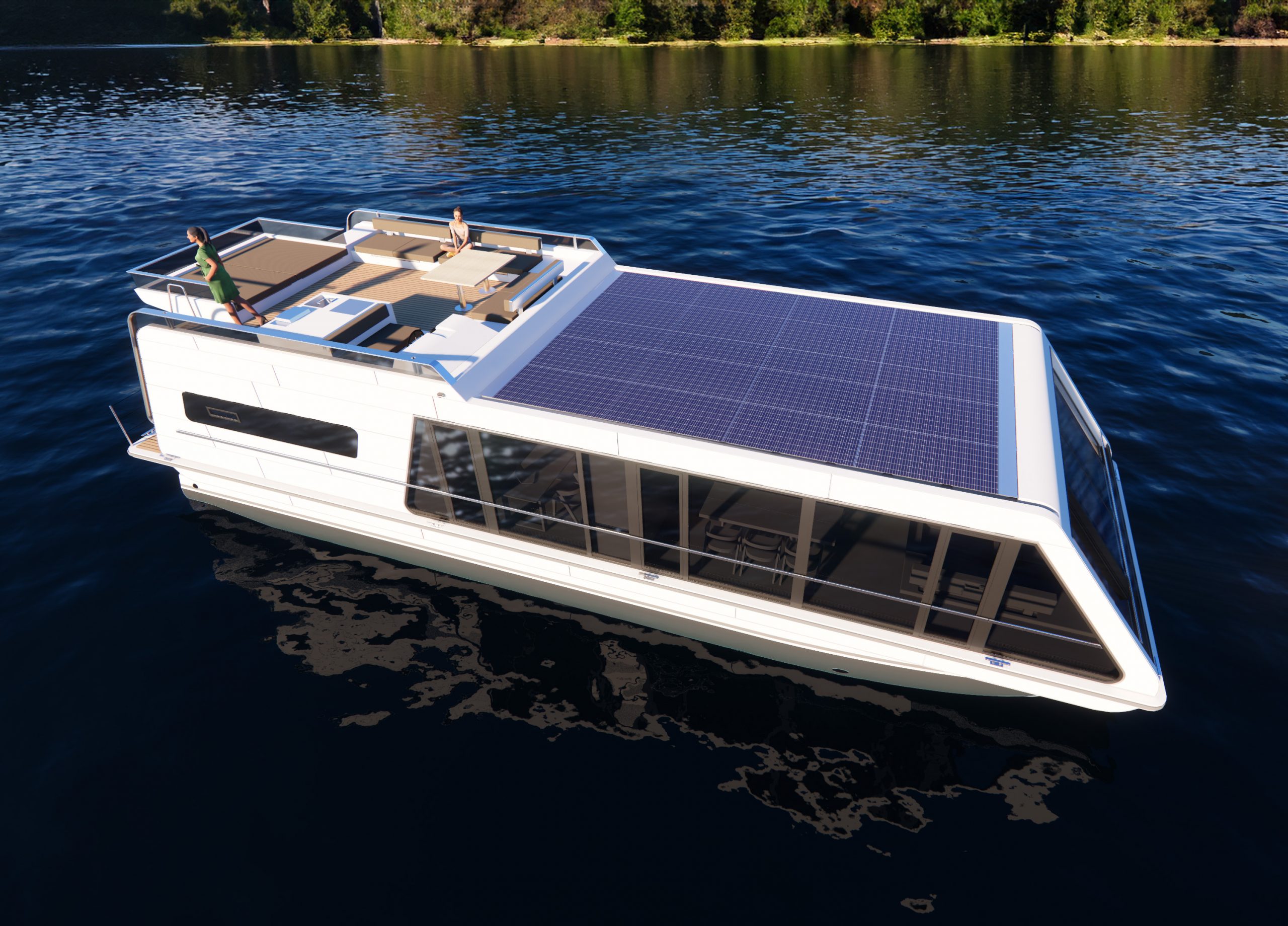

iYacht for Novaboat
designed, engineered and made in Germany living boats
Novaboat: designed, engineered and made in Germany living boats
Raoul Amon, the CEO of Novaboat, prefers to call his boats living boats rather than mere houseboats.
This definition becomes immediately apparent when stepping onboard: meticulously planned and executed, down to the last detail. Novaboat incorporates new technology and materials for both systems and fittings.
And of course, no compromises in terms of comfort, which is the paramount feature for a living boat.
At iYacht, we designed and engineered Novaboat’s NOVA56, which are proudly crafted in Germany, and can now be rightfully labeled as designed, engineered and made in Germany.
The birth of a new living boat
After developing the first model of the brand, the NOVA 42, Raoul Amon approached iYacht GmbH with a vision for a new living boat intended to raise the bar furthermore, building upon the insight gained from the NOVA 42. Udo Hafner, CEO of iYacht, was asked to create a symbiosis of a yacht and a house.
“Many clients come to us because they have a very clear idea of their project but have not yet found a partner able to provide them with the right solutions. What can appear straightforward to non-expert eyes, is in some cases a complex process that brings many challenges. At iYacht, we assist in shaping this process and solve these challenges” says Udo Hafner. “Raoul had a clearly defined goal that we were able to meet: this is how the production-ready NOVA 49 was created.“
To ensure the feasibility of the boat’s required characteristics, Raoul and Udo decided to engage the shipyard and suppliers early in the design process.
Simultaneously, another project was under development: the NOVA56.
Larger than the NOVA49, this modular living boat is available in 3 variants: 14m, 17m and 20m in length.
Ultimately, this project was prioritized over the NOVA49, and Raoul Amon appointed a specialized aluminum structures builder, with direct waterfront access, as the primary site for the building process of the NOVA56.
In order to enhance the expertise of the shipyard and the suppliers before embarking on a complex, production series project, Raoul and Udo proposed implementing all the technological developments in a one-off construction of 17m.
This vessel would serve as a demo boat, promoting the business, generating interest and sales for the production boats, and allowing potential customers to witness firsthand the quality of the living boat.
Building the prototype also served as a means for the shipyard and suppliers to refine their skills, better estimate the required resources and time, and streamline processes: a necessary learning curve before transitioning to series production.
At the time, it was clear that it was necessary to start with a one-off in order to allow the yard and the suppliers to gather the expertise and learn the processes. Novaboat’s CEO confirms: “It’s not always easy to build a boat like this with lots of partners and suppliers involved”.
iYacht then became the point of reference for many suppliers involved and was tasked with addressing the challenges of engineering a prototype that could easily transition into series production. The flexibility and collaborative approach of iYacht, demonstrated by their continued support for NOVABOAT even after delivering the final designs, proved to be crucial.
For instance, a detailed study was required to engineer the flat roof of the NOVA 56. The roof needed to have a low superstructure height, matching that of the production boat. However, for this prototype, it had to be constructed from a wooden frame. This showcased the flexibility of Udo’s team, ensuring efficient problem-solving for NOVABOAT and its partners.
Light & Efficient
The engineering approach adopted for the development of the NOVA56 mirrors the approach of engineering yachts: increasing the efficiency, minimizing weight and conducting CFD studies on the hulls.
The NOVA56 achieves high efficiency through its lightweight construction, utilizing walls and floor sandwich construction, in-house developed construction techniques, and a sustainable decking made of natural fiber that is 100% recyclable. Despite its size of 17m x 5.5m, the boat will weigh only 20 tons when ready to sail, a notable achievement.
The optimized hulls allow the two built-in 110 hp diesel engines to propel the NOVA56 to a top speed of 15 knots. While this speed is sufficient for activities like wakeboarding, the primary goal of the CFD study was to increase efficiency at cruise speed rather than top speed.
In terms of driving technology, the similarities with a yacht are clear: CFD shaped hulls, built-in diesel engines with shaft system and very large side thrusters. However, once you step inside, it doesn’t feel like you’re on a boat. Instead, the interior resembles that of a house, offering spacious living areas.
To optimize the floor area, the main control station is located on the flybridge. Additionally, in the living area there is a second control station for use during bad weather and for increased security. Interestingly, this helm is cleverly hidden under the couch, a design choice that further enhances the house-like feel of the interiors of this living yacht.
Self-sufficient living boats
The ample available spaces, 80 m² plus a flybridge of 30 m², make the NOVA56 suitable for living.
For those who choose to live permanently onboard, without being confined to a marina or close proximity to other boats, the NOVA56 has been designed to be completely self-sufficient.
To achieve this self-sufficiency, the NOVA56 is equipped with a solar system for independent electrical supply. The 35 m² solar roof harnesses the sun’s power to generate up to 6 kWp of sustainable energy. Intelligent smart home systems ensure efficient electrical energy usage. For instance, this system is connected to a weather service and can adjust consumption and make recommendations based on expected sunshine, even suggesting postponing laundry on rainy days until a sunnier day.
The boat also includes a water treatment plant, sewage treatment plant, and diesel generator. This setup ensures electrical self-sufficiency throughout the year. In the winter months, the generator can automatically switch on in emergencies.
Last but not least, there’s a boat garage for a 4×2 m dinghy. The dinghy remains hidden, which is a unique feature for this kind of boat. Often overlooked, the dinghy plays an important role in ensuring self-sufficiency, as it allows for independent short trips to shore
Comfortable interior
The meticulously planned layout of the NOVA56 can accomodate up to 12 people.
It features a unique foreship recessed sofa, which, upon opening the electric-operated front sliding door, converts into a cozy open-air area. This is also a space-saving solution, as it makes this space more versatile and eliminates the need for a bow terrace
The interior features a dining table for 8 people, a small office area, and a home cinema with a 2.5 m wide screen. When visitors are on board, a temporary “home cinema area” can be easily created by moving a sandwich panel.
Owner cabin is complemented with a dressing room, and a spacious bathroom with shower and bathtub.
Also the guest room has a separate bathroom with its own shower.
Among the comfort features of the NOVA 56 is the cantilevered solarium located on the 30m^2 flybridge. Seamlessly integrated into the superstructure, it acts as a roof providing extra weather protection to the main entrance while creating a spacious sunbed area, enhancing the overall appeal of the houseboat.
Designed for travel, the NOVA 56 is equipped with a robust engine setup, including inboard engines instead of outboards, and a sturdy aluminum hull. This houseboat boasts ease of maneuverability compared to many of its counterparts, thanks to the large thrusters and enhanced visibility from the helm installed on the flybridge.
iYacht’s involvement
iYacht was responsible for the detailed design and engineering of the NOVA 56, a task to be done while maintaining the family feeling of the whole Novaboat range and some innovative concepts developed for the Nova 42.
“I was already familiar with iYacht, but I thought they were handling only large projects. However, when I met Udo at a houseboat conference, I told him about my project and he agreed to help me solve some challenges I was experiencing. Udo immediately embraced the challenge and his team did solve them. I am very satisfied with the cooperation.” explains Raoul Amon.
With a wealth of experience spanning 15 years in houseboats and floating facilities, Udo Hafner, CEO of iYacht, has co-authored a comprehensive book about houseboats with the editor-in-chief of BOOTE. This book delves into every aspect of houseboat design—from initial planning, technology, hull shapes, materials, down to obtaining CE approval.
Among the notable projects realized by iYacht is the engineering of production houseboats for Caravanboats. The Hamburg and Kiel based studio also played a key role in the realization of the entire Lankenauer Höft project in Bremen: the first houseboat facility in the Hanseatic city.

